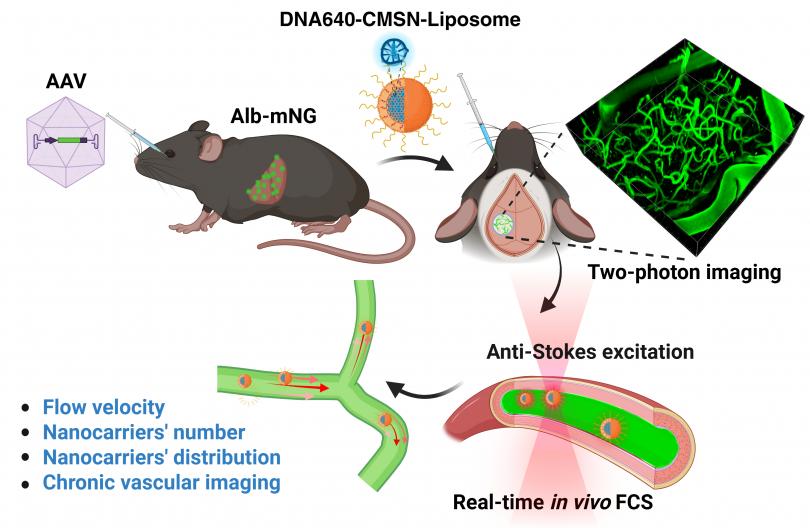 Cerebrovasculature refers to the network of blood vessels in the brain, and its coupling with neurons plays a critical role in regulating ion exchange, molecule transport, nutrient and oxygen delivery, and waste removal in the brain. Abnormalities in cerebrovasculature and disruptions of the blood supply are associated with a variety of cerebrovascular and neurodegenerative disorders. Nanocarriers, a nano-sized drug delivery system synthesized from various materials, have been designed to encapsulate therapeutic agents and overcome delivery challenges in crossing the blood-brain barrier (BBB) to achieve targeted and enhanced therapy for these diseases. Unraveling the transport of drugs and nanocarriers in the cerebrovasculature is important for pharmacokinetic and hemodynamic studies but is challenging due to difficulties in detecting these particles within the circulatory system of a live animal. In this dissertation, we developed a technique to achieve real-time in vivo tracking of nanocarriers in the cerebrovasculature using fluorescence correlation spectroscopy (FCS), which has great potential for determining the pharmacokinetics of drugs and nanocarriers, as well as for studying disease-related connections between the cerebrovascular and neurodegenerative diseases.
Cerebrovasculature refers to the network of blood vessels in the brain, and its coupling with neurons plays a critical role in regulating ion exchange, molecule transport, nutrient and oxygen delivery, and waste removal in the brain. Abnormalities in cerebrovasculature and disruptions of the blood supply are associated with a variety of cerebrovascular and neurodegenerative disorders. Nanocarriers, a nano-sized drug delivery system synthesized from various materials, have been designed to encapsulate therapeutic agents and overcome delivery challenges in crossing the blood-brain barrier (BBB) to achieve targeted and enhanced therapy for these diseases. Unraveling the transport of drugs and nanocarriers in the cerebrovasculature is important for pharmacokinetic and hemodynamic studies but is challenging due to difficulties in detecting these particles within the circulatory system of a live animal. In this dissertation, we developed a technique to achieve real-time in vivo tracking of nanocarriers in the cerebrovasculature using fluorescence correlation spectroscopy (FCS), which has great potential for determining the pharmacokinetics of drugs and nanocarriers, as well as for studying disease-related connections between the cerebrovascular and neurodegenerative diseases.

We utilized novel fluorescent probes composed of DNA-stabilized silver nanocluster (DNA-Ag16NC), that emit in the first near-infrared window (NIR-I) upon two-photon excitation in the second NIR window (NIR-II), encapsulated in liposomes, which were then used to measure cerebral blood flow rates in live mice with high spatiotemporal resolution by two-photon in vivo FCS. Liposome encapsulation concentrated and protected DNA-Ag16NCs from in vivo degradation, enabling the quantification of cerebral blood flow velocity within individual capillaries of a living mouse. We also loaded another DNA-stabilized silver nanocluster (DNA640), which exhibited higher quantum yield and anti-Stokes fluorescence upon upconversion absorption, into cationic mesoporous silica nanoparticles (CMSNs) and successfully coated them with liposomes. The cerebrovasculature was chronically labeled using an adeno-associated viral (AAV) vector encoding Alb-mNG secretion into the bloodstream, combined with FCS under upconversion excitation, enabling real-time observation of the flow velocity and particle number of DNA640-CMSN-liposomes within the capillaries. We applied our proposed techniques to study the cerebrovascular structure and blood flow velocity in Alzheimer's disease mouse models and to explore the effects of disease-related conditions on vasoconstriction and vasodilation.
KEYWORDS: Cerebrovascular, nanocarrier, FCS, NIR fluorescence, DNA-AgNC, in vivo
Zoom link: https://uky.zoom.us/j/5984755867?omn=87194697892
Meeting ID: 598 475 5867.
